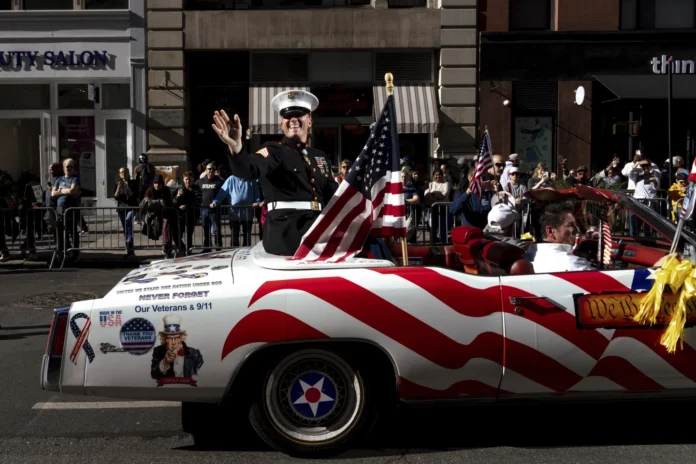President Joe Biden lay a wreath at Arlington National Cemetery on Monday in honor of Veterans Day, while thousands marched through New York’s streets. Smaller parades were staged across the country to honor those who have served in the United States military.
The Veterans Day holiday began more than a century ago, albeit under a different name, to commemorate the end of World War I. Over time, its name and purpose expanded into a day to honor all war veterans in the United States, as well as those presently serving in service.
Many schoolchildren, as well as postal workers and other federal government employees in the United States, have the day off. Several companies and businesses provide prizes and discounts.
Here’s a look at how the United States commemorates Veterans Day and how it originated:
What’s the history of Veterans Day?
It originated as Armistice Day, commemorating the agreement between the Allied nations and Germany to end all fighting during World War I, which went into effect at 11 a.m. on November 11, 1918.
In 1919, President Woodrow Wilson declared the first Armistice Day in the United States. In 1938, Congress designated November 11 as an official federal holiday.
After World War II, a holiday honoring those who served in what was dubbed “the war to end all wars” was reevaluated. In 1954, Congress changed the name to Veterans Day, reflecting a broader goal of honoring veterans from all wars.
Other adjustments were not warmly welcomed, according to the US Department of Veterans Affairs website. In the early 1970s, federal Veterans Day observances were changed to Mondays, generating confusion because several states continued to celebrate on November 11.
In 1975, President Gerald Ford signed legislation reverting federal observances to November 11. Since then, the United States has honored Veterans Day on that date.
How is Veterans Day commemorated?
Since the inaugural Armistice Day in 1919, communities around the United States have organized parades to honor war heroes on November 11.
The nation’s largest Veterans Day parade takes place in New York, with a procession down Fifth Avenue in Manhattan. The United War Veterans Council, which organizes the parade, projected that 20,000 marchers would take part in 2024.
Presidents of the United States lay wreaths at Arlington National Cemetery’s Tomb of the Unknown Soldier, located outside of Washington. In remarks at the cemetery’s memorial amphitheater Monday, Biden stated that it had been his life’s privilege to serve as commander in chief of “the finest fighting force in the history of the world.”
Other countries, including as the United Kingdom, Canada, and Australia, also recognize veterans on or around November 11. They call their commemorative day Remembrance Day.
How is Veterans Day different from Memorial Day?
While Veterans Day activities often focus on thanking all living and deceased U.S. military veterans, Memorial Day observances have traditionally focused on honoring those died in wars.
Memorial Day originated after the Civil War, with the first national observance of what was then known as Decoration Day on May 30, 1868. An organization of Union Army veterans advocated for the decoration of battle graves with flowers.
Since 1971, Memorial Day in the United States has been observed on the final Monday of May rather than May 30. The subsequent three-day weekend has sparked some criticism that the day’s original purpose of solemn remembrance has been undercut by its more relaxed celebration as the unofficial start of summer.
What’s open and closed on Veterans Day?
Veterans Day is a federal holiday, hence the US Postal Service does not deliver mail on that day. Other government agencies, including federal courts, are also closed.
Most banks in the United States take the day off, as do many public schools.
The New York Stock Exchange and Nasdaq remain operational, while the bond markets are closed.
Though some private businesses observe Veterans Day, most merchants remain open, with many giving special discounts. Many restaurants provide complimentary meals to veterans and active members of the military, who also receive Veterans Day discounts from businesses. According to a list compiled by the Department of Veterans Affairs, certain zoos and museums waive entry, while other businesses provide free haircuts and car oil changes.
